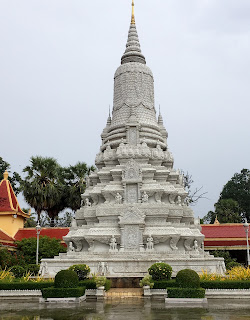Our driver and guide pick us up at our hotel for a day of sightseeing around Phnom Penh. The driver has the radio display on, but no volume, but I can see the artists - I notice both Taylor Swift and Rihanna are playing on the channel. Looks like it's the same music everywhere!
 |
| One of the buildings on the Imperial Palace grounds. |
 |
| I can't take a picture of the expensive buddhas, but I can take a picture of the ornate door! |
We also see some valuable Buddhas while we're here (one made of gold and diamonds, another of jade), but we can't take pictures. We do discover that the different hand positions give the Buddhas different values - some are for protection, or gaining money, etc.
 |
| Having fun at one of the other door/gates. |
The previous five kings are cremated and kept in giant carved stone monuments on the palace land.
 |
| Nice gravestone. It's about 20 ft high. |
 |
| Close up of some of the monument carvings. Would it be wrong to use it as a quilting inspiration? |
 |
| Naga handrail |
There are decorative gardens at the palace. I like the palm tree fan.
 |
| A fan this size would keep you cool on a hot day! |
We're excited to see a banyan tree in bloom! Must take selfie with it!
 |
| Yay! The rain stopped, too. |
 |
| Steve, protected by the naga. |
 |
| Lotus blossoms for purchase as offerings. |
 |
| Offerings left at a statue |
 |
| Buddha at Wat Phnom - I can take a picture of this one! |
Most people are praying, leaving offerings, or lighting incense (or some combination of all three). The building is full of Buddhas and statues. In a way it reminds me of the saints at a Catholic church. But then there's this guy, sitting in front of the Buddha and reading the newspaper.
 |
| If he's reading a religious article, does that make it okay? |
Wat Phnom is at the top of a large hill, and there are also other buildings and pagodas located here. I like the fun statues that are displayed on the grounds. Around the bottom of the hill the area has been made into a park. Only foreigners have to pay to see the pagoda ($1/person) - it's free for Cambodians.
 |
| Lion? Dragon? Either way, where can I get one? |
 |
| Pretty park views |
 |
| The monk doesn't really look impressed with the offering. |
 |
| Lunchtime...obviously the dog is not fed from the table. |
 |
| serving lunch |
It's interesting to see women are involved with the monastery, preparing and serving the food (I saw men serving, too). There are also numerous dogs and cats running around. Maybe they get the leftovers?
We go off to have our own lunch at one of the restaurants in town. We decide we really like Cambodian food! The spices are a blend of Thai and Vietnamese, which makes sense since Cambodia is between the two countries. For protein they eat mainly pork and chicken, but it's similar to Bali (and the US) - it's lean. Japan likes a lot of fat in their meat, and I end up cutting off most of what I'm served. Vietnam also uses all parts of the animal like in Japan - so you might want to ask (or maybe not!) what part of the animal you're eating. Cambodia seems to have the "usual" animal parts - like chicken breast and thigh - to eat.
 |
| Genocide Museum |
After the Cambodian Civil War, the Khmer Rouge regime, led by Pol Pot, arrested and eventually executed almost everyone suspected of connections with the former government or with foreign governments, as well as professionals and intellectuals. It's calculated that the Khmer Rouge killed about 25% of the Cambodian population, their own people, during the four years they were in power.
 |
| Killing Field |
 |
| A picture Steve took of the ground at the Killing Fields. Teeth are scattered on the surface of the ground. |
A commemorative stupa at the site displays the skulls of the victims. It's several stories high, and documents (if known) male or female, age and how the person was killed.
 |
| Each row is about 100 sq feet, and it goes up several stories. |
Visiting both sites is difficult, but I feel it's necessary to be a witness. There's more I could say but I don't feel like this is the appropriate venue for it.
No comments:
Post a Comment